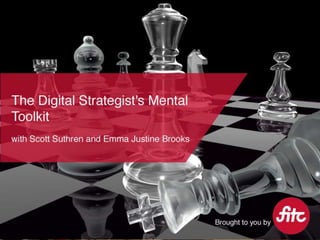DSMT - Insight creation
- 2. Digital Strategistâs Mental Toolkit: Insight creation_ Photo: http://www.flickr.com/photos/47292975@N05/4398070128
- 3. Key points_ What this section will cover: âĒ Insight definition âĒ Triggers and tools âĒ Making the decision Photo: http://www.flickr.com/photos/47292975@N05/4398070128
- 4. Definition of an insight_ An unexpected but simple universal tension that exists between the target and the product Photo: http://www.flickr.com/photos/47292975@N05/4398070128
- 5. Definition of an insight_ Aha! Photo: http://www.flickr.com/photos/47292975@N05/4398070128
- 6. Definition of an insight_ Insights arenât so much created as they are triggered. Photo: http://www.flickr.com/photos/47292975@N05/4398070128
- 7. A great insight_ People donât want a quarter-inch drill, they want a quarter-inch hole. Jeremy Bullmore, WPP Photo: http://www.flickr.com/photos/47292975@N05/4398070128
- 8. A great insight_ Virgin Express is inexpensive but not cheap. Source: PSFK Photo: http://www.flickr.com/photos/47292975@N05/4398070128
- 9. Insight triggers_ âĒ Gather raw material âĒ Intake and ruminate âĒ Look for commonalities âĒ Find and explore relationships that have tension or unresolved issues âĒ Search for outliers, incongruities âĒ Debate and discuss with everyone Photo: http://www.flickr.com/photos/47292975@N05/4398070128
- 10. Insight triggers_ âĒ Debate with a team member âĒ Engage in mental simulation âĒ Use metaphor and analogy âĒ Do storytelling âĒ Improvise the answer Photo: http://www.flickr.com/photos/47292975@N05/4398070128
- 11. Trigger tools_ 1. Assume a beginners mindset â Donât judge information as it comes in â Question everything â Really listen and take in the information Photo: http://www.flickr.com/photos/47292975@N05/4398070128
- 12. Trigger tools_ 2. What, How, Why method â What is the information you are looking at? What is happening? â How is it relevant? How many ways can it be interpreted? â Why should it be considered? Why is it happening? Photo: http://www.flickr.com/photos/47292975@N05/4398070128
- 13. Trigger tools_ 3. Madlib â Play with combinations and templates to trigger thoughts â [consumer] needs to [utility] because [external force] Photo: http://www.flickr.com/photos/47292975@N05/4398070128
- 14. Trigger tools_ 4. K-J Technique â Eliminate team bias through silence â Allows for generation and classification of many ideas Photo: http://www.flickr.com/photos/47292975@N05/4398070128
- 15. Trigger tools_ 5. Constrained brainstorming â Better than standard brainstorming â Allow criticism, devils advocate, constraints â Results in better insight generation Photo: http://www.flickr.com/photos/47292975@N05/4398070128
- 16. Decision making with limited input_ How will you know if you have to go with what you have? âĒ Engage in mental simulation âĒ Use metaphor and analogy âĒ Do storytelling âĒ Improvise the answer Go with your gut. Photo: http://www.flickr.com/photos/47292975@N05/4398070128













![Trigger tools_
3. Madlib
â Play with combinations and templates to trigger thoughts
â [consumer] needs to [utility] because [external force]
Photo: http://www.flickr.com/photos/47292975@N05/4398070128](https://image.slidesharecdn.com/dsmtinsightcreation-120529150719-phpapp02/85/DSMT-Insight-creation-13-320.jpg)


